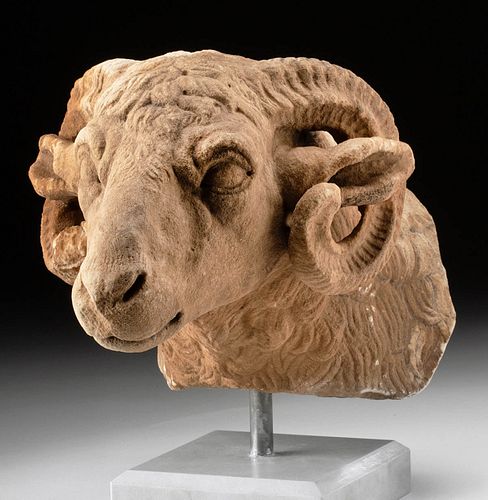Remarkable Roman Marble Ram's Head
Lot 39
About Seller
Artemis Fine Arts
686 S Taylor Ave, Ste 106
Louisville, CO 80027
United States
Selling antiquities, ancient and ethnographic art online since 1993, Artemis Gallery specializes in Classical Antiquities (Egyptian, Greek, Roman, Near Eastern), Asian, Pre-Columbian, African / Tribal / Oceanographic art. Our extensive inventory includes pottery, stone, metal, wood, glass and textil...Read more
Categories
Estimate:
$20,000 - $30,000
Absentee vs Live bid
Two ways to bid:
- Leave a max absentee bid and the platform will bid on your behalf up to your maximum bid during the live auction.
- Bid live during the auction and your bids will be submitted real-time to the auctioneer.
Bid Increments
| Price | Bid Increment |
|---|---|
| $0 | $25 |
| $300 | $50 |
| $1,000 | $100 |
| $2,000 | $250 |
| $5,000 | $500 |
| $10,000 | $1,000 |
| $20,000 | $2,500 |
| $50,000 | $5,000 |
| $100,000 | $10,000 |
| $200,000 | $20,000 |
About Auction
By Artemis Fine Arts
Oct 8, 2020
Set Reminder
2020-10-08 10:00:00
2020-10-08 10:00:00
America/New_York
Bidsquare
Bidsquare : Exceptional Antiquities, Asian, Ethnographic
https://www.bidsquare.com/auctions/artemis-gallery/exceptional-antiquities-asian-ethnographic-5796
Museum-worthy examples of Egyptian, Greek, Roman, Etruscan, Near Eastern, Far East / Asian, Pre-Columbian, African / Tribal,Oceanic, Native American, Spanish Colonial, Russian, Fossils, Ancient Jewelry, Fine Art, so much more! Artemis Fine Arts info@artemisgallery.com
Museum-worthy examples of Egyptian, Greek, Roman, Etruscan, Near Eastern, Far East / Asian, Pre-Columbian, African / Tribal,Oceanic, Native American, Spanish Colonial, Russian, Fossils, Ancient Jewelry, Fine Art, so much more! Artemis Fine Arts info@artemisgallery.com
- Lot Description
Roman, Imperial Period, ca. 1st century CE. An expertly carved marble ram’s head with incredibly lifelike details, presenting mesmerizing large eyes with ample lids, a prominent snout with delineated nostrils and closed mouth, a curly forelock, a full wavy coat, and pointed ears protruding from either side of the head beneath grand curled, ribbed horns. By Roman times, the ram was already an ancient (with respect to the Romans) symbol of virility and masculinity, and the god Mercury (Greek Hermes) was often accompanied by a ram to symbolize fertility. Size: 11.375" L x 8.125" W x 7.625" H (28.9 cm x 20.6 cm x 19.4 cm); 9.875" H (25.1 cm) on included custom stand.
This piece was either intended to be free-standing or possibly created as an architectural decoration, as ram heads and other animal heads were popular choices for architectural embellishments. These were oftentimes positioned at the upper corners of Roman funerary altars.
A similar Roman marble ram head realized GBP 275,000 at Christie’s London, Sale 17198, 3 July 2019, lot 97. According to their lot essay, “For a related ram head in Boston, thought to be Greek, circa 4th century B.C., see no. 39 in Comstock and Vermeule,
Provenance: acquired in 1906 in Greece by A. Nascou (great-grand daughter) who purchased them from Mr. A.T. Gaines
All items legal to buy/sell under U.S. Statute covering cultural patrimony Code 2600, CHAPTER 14, and are guaranteed to be as described or your money back.
A Certificate of Authenticity will accompany all winning bids.
We ship worldwide and handle all shipping in-house for your convenience.
#159307A fragment of a larger sculpture with chips/losses to neckline as shown. Right horn was repaired from about 3 pieces and shows loss to the tip. Drill hole on bottom for attaching to stand. Expected surface wear with nicks/abrasions to high-pointed areas commensurate with age. Marble surface presents with a red hue over much of the surface due to iron rich deposits. One can see the original white hue of the marble at break lines on the neck. There are also areas of white and scattered black deposits.Condition
- Shipping Info
-
All shipping is handled in-house for your convenience. Your invoice from Artemis Gallery will include shipping calculation instructions. If in doubt, please inquire BEFORE bidding for estimated shipping costs for individual items.
-
- Buyer's Premium



 EUR
EUR CAD
CAD AUD
AUD GBP
GBP MXN
MXN HKD
HKD CNY
CNY MYR
MYR SEK
SEK SGD
SGD CHF
CHF THB
THB














